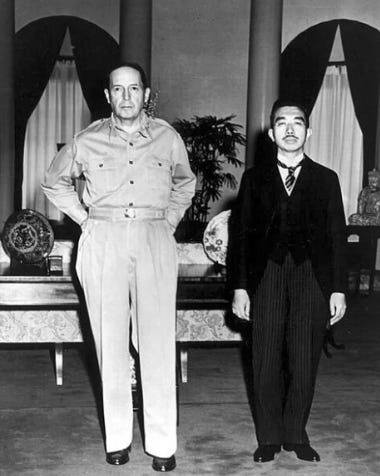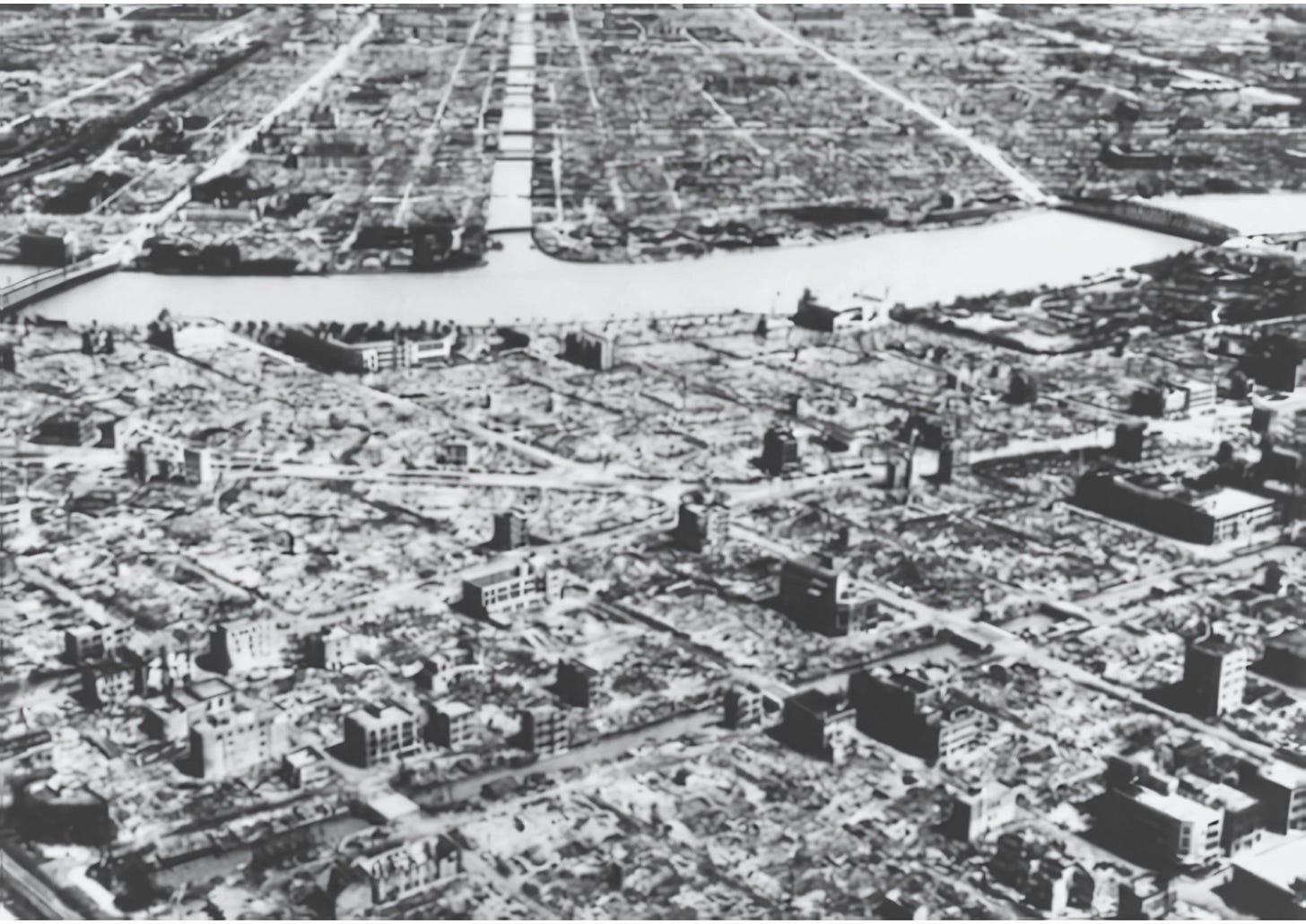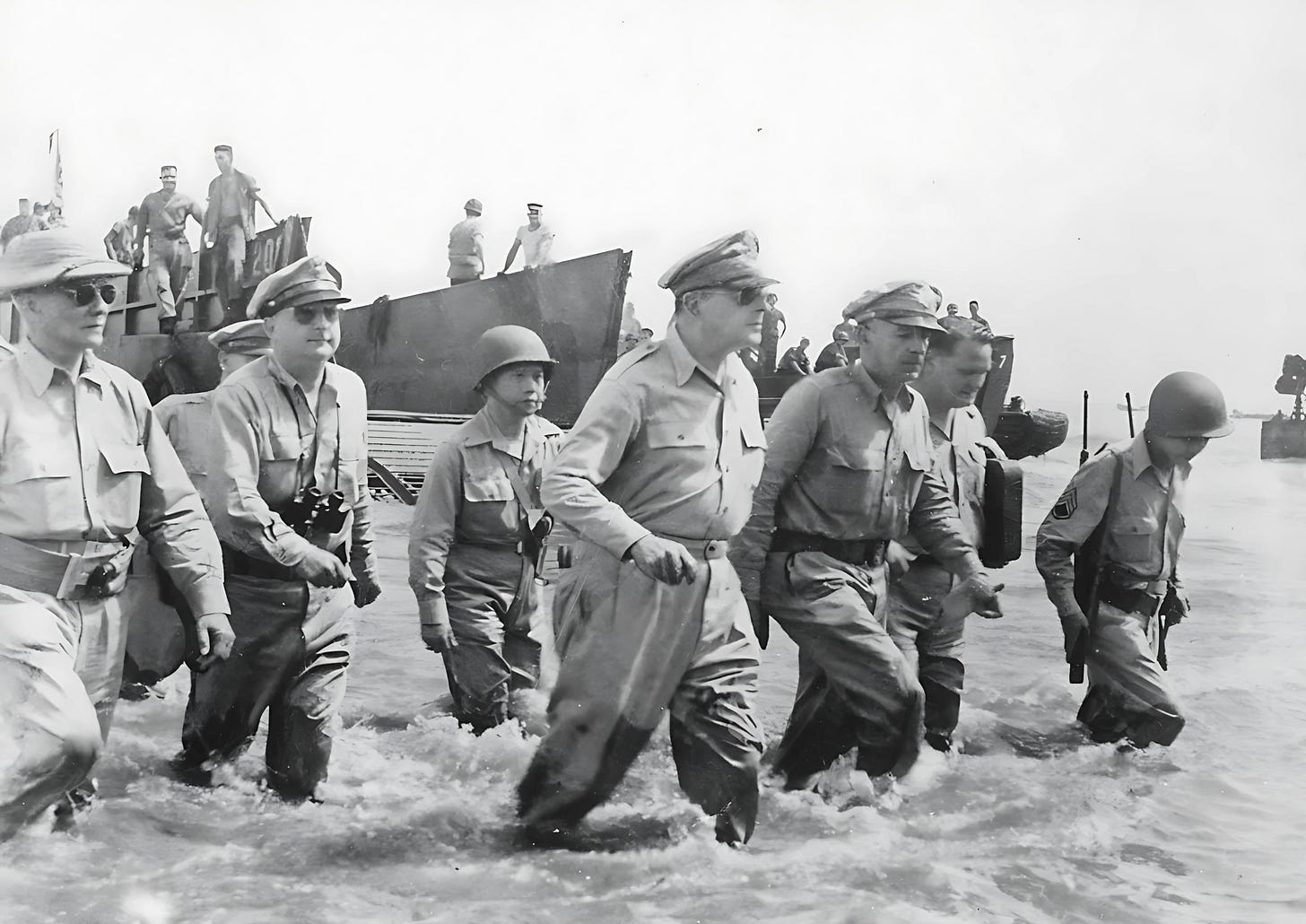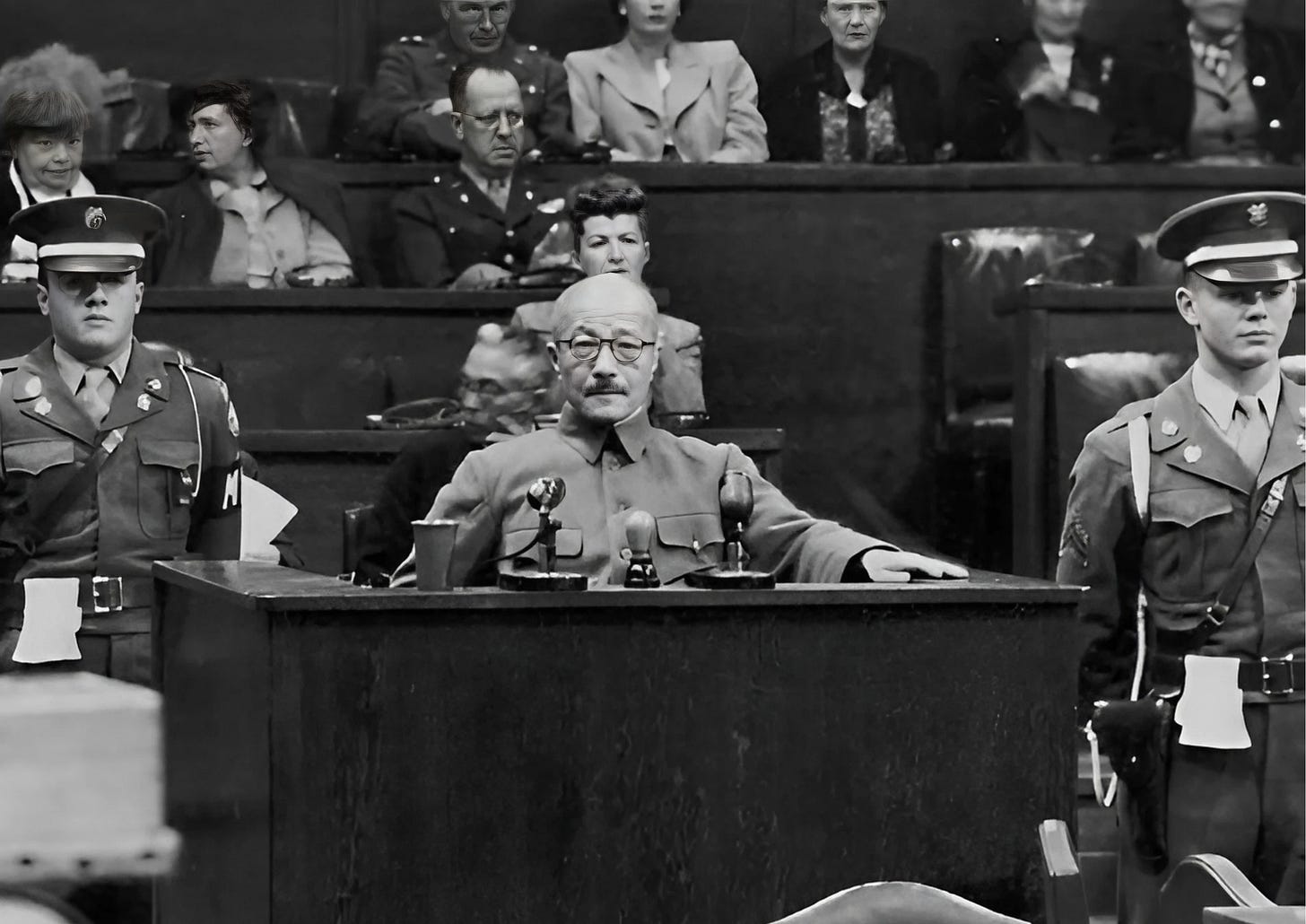Eighty years ago tomorrow, General Douglas MacArthur flew into Atsugi Airbase, just outside Tokyo. As anniversaries go, the moment is rarely placed up there alongside Pearl Harbor, Hiroshima and Japan’s surrender. But it should be. This was the beginning of the Allied Occupation of Japan, which over the course of nearly seven years radically reshaped the country. If you go to Japan now, in all sorts of ways you’ll encounter the fruits of this turning-point period in its history.
I’m going to explore that radical reshaping across the course of my first ‘deep-dive’ series. We’ll look at the Occupation of Japan from five very different perspectives, starting with MacArthur himself: the ‘blue-eyed shogun’ (aoi me no shōgun) as some in Japan took to calling him. Later, we’ll take the view of an infamous gangster, a path-breaking pop star, a legendary manga artist and a celebrated entrepreneur - the founder of Sony, no less, which started out during the Occupation stealing fuel from the US Army.
These deep dives are a new offering on my Substack. Each one is designed to run over a few months, delving into some aspect of Japanese history or culture. Coming up, you’ll find out how to ‘read’ Japanese gardens, temples and shrines; who’s who in Japanese mythology; and recommendations for Japanese fiction in translation. A ‘Japan Now’ series also begins next month, providing context and commentary on contemporary Japan.
Deep Dives and Japan Now will be part of a new paid tier, aimed at helping this publication and my associated Instagram account to grow and serve more people. I’m setting it at the lowest amount Substack allows: £3.50 ($5) per month, or £30 ($50) for the year. Paid subscribers will also receive invitations to quarterly live Q&A sessions, on topics we’ll choose together.
I’m grateful to everyone who takes the time to read this newsletter, and it’s a huge encouragement to now have more than 1,000 subscribers. If you want to remain a free subscriber, I would value that very highly indeed. Two posts per month will always be free to read and share. This post, on MacArthur, is available for all. And if you’d like to try the paid tier articles for a month, just drop me a line and I’ll set you up with a gift subscription.
If you’d like to become a paid subscriber, thank you! You don’t have to do anything right now.
If one image became synonymous with the Allied Occupation of Japan, it’s this one, taken in September 1945 and showing Douglas MacArthur - Supreme Commander for the Allied Powers - looming over Emperor Hirohito.
An image like this could not have been created during or before the war. Imperial Household photographers were under orders to stay at least twenty metres back from the Emperor when photographing him, and to use telephoto lenses. Shots from sideways on were discouraged because of Hirohito’s slight stoop. Hirohito’s tailor, meanwhile, was not allowed to touch him - which may be why his suit here appears not to fit him very well.
This photograph was considered such an embarrassment at the time that the Japanese Cabinet actually tried to ban the media from publishing it. But the administration under MacArthur’s command, known as GHQ, overturned the ban and insisted that the photo be published - recognising the message that it would send.
For me, this photo sums up the Occupation very well: an ‘Allied’ effort that in reality was run by the United States, with the Emperor - and, more broadly, the people of Japan, the junior partner.
It represents it - but it doesn’t explain it. Most importantly, it doesn’t explain why people in Japan appeared to accept Occupation so willingly - after a bitterly-fought war, which they had been told by their government was a fight for their country’s very existence.
If you want a photo that explains that willingness, try this one:
This is early postwar Tokyo from the air: a city devastated by fire-bombings, like most of those around Japan were.
The technology was American: napalm was tested on Japanese-style architecture in the US, before being deployed against real targets across Japan.
But the fault, in large part, lay with Japan’s leadership. Having entered their people into war with the US and Great Britain, they then failed to defend them - from hunger, conscription and attacks by enemy bombers. Very few anti-aircraft guns or fighters were deployed to defend Japan’s cities. People were basically told to fend for themselves.
This was how many in Japan felt, and it was very much the version of events that the United States presented to the Japanese after the war. Unsure of how the population might respond to Occupation, planners put their faith in a few key ideas:
Democracy was the natural desire, and means of flourishing, of people the world over. Give Japan democracy and the result would be gratitude and the unleashing of everyone’s creative energies.
Militarists had corrupted Japanese politics, business and armed forces. Root and branch reform was required, and would be welcomed by ordinary people.
Since the late 19th century, Japan had modernized only in a limited sense. It had up-to-date institutions, technology, weapons, etc. But a feudal mindset persisted: people were too willing to do what their superiors told them, without questioning or developing a sense of civic responsibility. This must change.
These three ideas formed the backdrop to MacArthur’s early accomplishments after he set himself up in Tokyo - initially in the Imperial Hotel, opposite the Imperial Palace. Some American staff, in awe of him, joked that he could be seen early in the morning walking on the waters of the imperial palace moat.
Why this level of awe and adulation for MacArthur? A veteran of the First World War, he had gone on to serve as superintendent at West Point military academy, putting it through a radical process of modernization (including stamping out hazing, of which he himself had once been a victim). He became army chief of staff in the 1930s, before being recalled to active service after the outbreak of war with Japan. He was tasked in the summer of 1941 with helping the defence of the Philippines, in case the Japanese should attack.
Defenders of MacArthur would say that he made the best of a bad situation here. American and Filipino firepower was never enough to prevent the Japanese taking over. But MacArthur at least managed to slow the advance, before being ordered in March 1942 to relocate to Australia. From there he issued his famous declaration: ‘I shall return.’
MacArthur kept his word in the autumn of 1944, wading ashore as part of the initial US landing at Leyte, aimed at taking back the Philippines from Japan. But it was a costly campaign and MacArthur was criticised for turning it into a vanity project: its recapture was, in reality, of limited importance to the broader strategic goal of defeating Japan.
MacArthur’s record in Japan, at least early on, was stronger. He quickly made good on the three major objectives of the Occupation:
Demilitarization: Japan’s armed forces were disbanded and its empire broken up. The apparatus for its rudimentary nuclear programme was discovered and thrown into Tokyo Bay.
Decentralization of power: moves were made to break up the zaibatsu conglomerates which had controlled so much of the Japanese economy (and had ended up in cahoots with Japan’s militarists). As a ditty posted to the bulletin board of an American billet in Tokyo put it:
There’s something rather fishy
About the Mitsubishi
And the rest of the zaibatsu
Are also not so hot-su.
Democratization. In retrospect, it seems almost comical that Japan's surviving political leaders hoped, in the summer of 1945, to get away with minor revisions to the Meiji-era constitution - under whose auspices so much of the carnage of the previous years had occurred. They soon lost the argument and Japan became the first country in modern history to have its constitution authored for it by another.
Amongst the most important provisions of that constitution were - and remain:
Sovereignty in Japan derives from the people - not the Emperor, who was henceforth merely a ‘symbol’ of the state.
Legislative power is exercised by a bicameral Diet, elected by women alongside men (Japan’s pre-war feminists had tried and failed to secure the right to vote). Executive power rests in the Cabinet, responsible to the Diet.
The right to wage war, and the maintaining of the means to do so, is forever renounced.
Civil liberties are guaranteed, including freedoms of speech, religion and association, alongside rights to education and a minimum standard of living. Women have improved rights in areas like property and divorce.
In all of this, MacArthur embodied the Occupation’s sense of certainty about what Japan needed. He was never big on consultation. Nor was he willing to brook much dissent. Cartoonists were forbidden from creating caricatures of him. Films, kabuki plays, literature and magazines faced censorship, on the basis that the consequences of nationalistic or anti-American sentiment might quickly spiral given an exhausted and demoralised population. Millions of letters and packages were opened and checked. Even a relatively innocent haiku - Small green vegetables / Are growing in the rain / Along the burned street - was banned, as ‘Criticism of the United States.’
Meanwhile justice was meted out to a select group of wartime ringleaders. The International Military Tribunal for the Far East convened in April 1946, based on Nuremberg and overseen by eleven judges drawn from Allied nations. When the tribunal delivered its verdict, in November 1948, twenty-five defendants were each found guilty on at least one count. Seven, including former Prime Minister Tōjō Hideki, were sentenced to death.
Tōjō Hideki, on trial for his life at the International Military Tribunal for the Far East in Tokyo
Tōjō had suggested that the trial’s remit should extend back far beyond 1928 - the date chosen for considering the lead-up to war - and encompass the Opium Wars of the mid-nineteenth century. Those years, he claimed, had set the stage for what had just happened across the Asia-Pacific. To ignore them, and to refuse to consider the fire-bombings of Japanese cities or the use of atomic weapons against Hiroshima and Nagasaki, was to indulge in what critics of the trials came to call ‘Victors’ Justice.’
In important ways, however, the limiting of the Tokyo Trials worked well. The Japanese public saw their former leaders held to account, while effectively being absolved of guilt themselves. The Emperor was spared the ignominy of a trial, and the population at large was spared what would have been a truly devastating spectacle: an imperial line stretching back well over a thousand years coming to an end with a man swinging from a rope. MacArthur was surely correct to argue that were the Emperor to be tried and executed as a war criminal, there was a substantial risk of popular anger welling up and rendering Japan ungovernable.
By the end of 1948, MacArthur and his team of largely young and idealistic American personnel had well and truly put their stamp on Japan. And yet the Japanese were far from passive players in all this. In the next instalment, you’ll meet Kodama Yoshio: an ultranationalist and gangster who made tens of millions of dollars during the war and tried to use it during the Occupation to win himself some political influence.
Kodama was part of a bigger, fascinating picture: people in Japan, many of whose aspirations had been derailed either by the war or by defeat, trying to turn the Occupation to their advantage. MacArthur, the ‘Blue-Eyed Shōgun,’ was a powerful, imposing presence, who wielded extraordinary authority. But the battle for Japan was only just beginning.
—
Thanks for reading!
If you’ve enjoyed this post, please consider liking, sharing and - if you’re not yet onboard - subscribing. You’ll get new posts delivered to your inbox every Friday.
—
Images
General Douglas MacArthur and Emperor Hirohito: Wikipedia (public domain).
General Douglas MacArthur coming ashore in the Philippines, October 1944: Wikimedia Commons (public domain).
Tōjō Hideki in the dock: National WW2 Museum (fair use).









The photo of MacArthur and Hirohito has a back story. In the first try, MacArthur had his eyes closed; in the second try, Hirohito had his mouth open. The photo we have now was the third try by the photographer.
Thank you for this! The history of the American occupation of Japan fascinates me. I recommend anyone interested in the period to read John Dower’s Embracing Defeat–fantastic book.